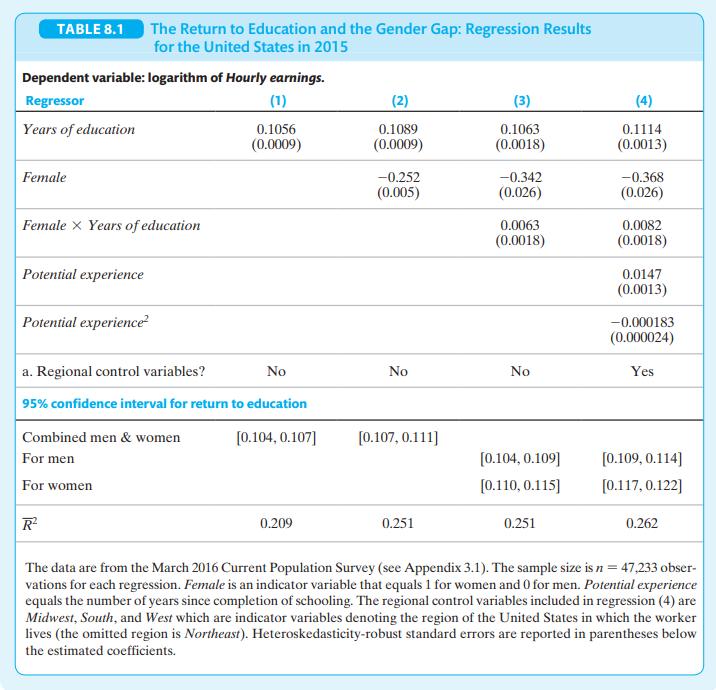Question:
The box "The Return to Education and the Gender Gap".
a. Consider a male with 16 years of education and 2 years of experience. Use the results from column (4) of Table 8.1 and the method in Key Concept 8.1 to estimate the expected change in the logarithm of average hourly earnings ( \(A H E\) ) associated with an additional year of experience.
b. Explain why your answer to (a) does not depend on the region he is from.
c. Repeat (a), assuming 10 years of experience.
d. Explain why the answers to (a) and (b) are different.
e. Is the difference in the answers to (a) and (b) statistically significant at the \(5 \%\) level? Explain.
f. Would your answers to (a) through (d) change if the person were female? Explain.
g. How would you change the regression if you suspected that the effect of experience on earnings was different for men than for women?
Table 8.1

Transcribed Image Text:
TABLE 8.1 The Return to Education and the Gender Gap: Regression Results for the United States in 2015 Dependent variable: logarithm of Hourly earnings. Regressor Years of education Female Female X Years of education Potential experience Potential experience a. Regional control variables? (1) (2) (3) (4) 0.1056 0.1089 (0.0009) (0.0009) 0.1063 (0.0018) 0.1114 (0.0013) -0.252 -0.342 -0.368 (0.005) (0.026) (0.026) 0.0063 0.0082 (0.0018) (0.0018) 0.0147 (0.0013) -0.000183 (0.000024) No No No Yes 95% confidence interval for return to education Combined men & women For men For women R [0.104, 0.107] [0.107, 0.111] [0.104, 0.109] [0.109, 0.114] [0.110, 0.115] [0.117, 0.122] 0.209 0.251 0.251 0.262 The data are from the March 2016 Current Population Survey (see Appendix 3.1). The sample size is n = 47,233 obser- vations for each regression. Female is an indicator variable that equals 1 for women and 0 for men. Potential experience equals the number of years since completion of schooling. The regional control variables included in regression (4) are Midwest, South, and West which are indicator variables denoting the region of the United States in which the worker lives (the omitted region is Northeast). Heteroskedasticity-robust standard errors are reported in parentheses below the estimated coefficients.







